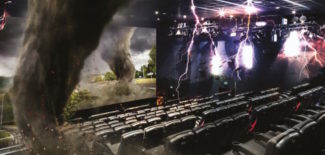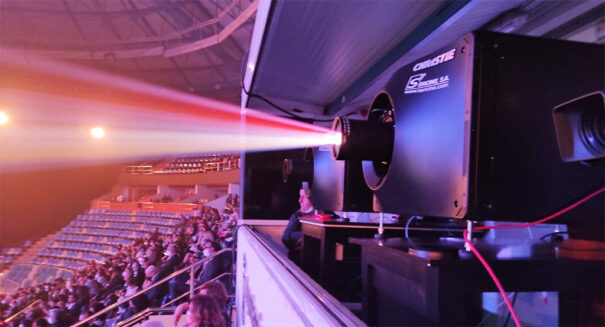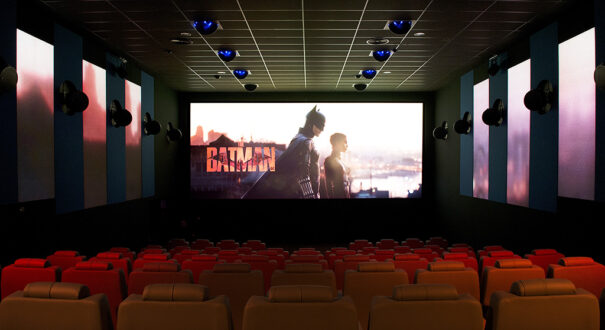5 tecnologías que marcarán (o no) el futuro de las salas de cine
Las salas de cine son, por sí mismas, toda una experiencia. Pero al tiempo que los fabricantes de soluciones invitan a los consumidores a toda una carrera tecnológica en sus hogares, los grandes exhibidores se plantean alternativas que buscan invitar a los espectadores a vivir un acontecimiento colectivo y totalmente rompedor frente a la gran pantalla.
En plena vorágine de redefinición industrial en cuanto a modelos de negocio de distribución, las salas abordan un periodo en el que la tecnología se presenta como una aliada. No es nada nuevo: a lo largo de la historia del cine, las innovaciones técnicas (ya fuera la implementación del sonido, Cinerama, 3D or audio inmersivo, por citar unos pocos ejemplos) han tratado de solucionar incertidumbres con mayor o menor suerte.
En la actualidad, la consolidación de los servicios de streaming (en 2021 el 57% de los españoles vio series o películas en plataformas VOD según el último informe Sociedad Digital en España de Telefónica), la imprevisibilidad que acompaña un mundo postCOVID y una notable subida de los precios, lleva a la industria a plantear y comercializar nuevas soluciones tecnológicas para luchar contra el sempiterno miedo a las salas vacías.
Algunas triunfarán. Otras, quedarán en el olvido. Pero merece la pena asomarse para descubrir ciertas tecnologías que, inevitablemente, ya están condicionando la fase de producción y postproducción de grandes blockbusters.
1. iBeacon: experiencia tecnológica antes de entrar en la sala
Una tendencia que defiende una importante parte de la industria es la de hacer del “ir al cine” un nuevo concepto. Gurús, integradores y ejecutivos defienden que la experiencia de ir al cine y asistir a un momento de contemplación colectiva en el que las luces se apagan y el mundo se pausa, por sí misma, no es suficiente. Al igual que se confirma con los grandes eventos deportivos, el camino pasa por invitar al espectador a llegar antes a la sala y aportarle una experiencia ampliada. Así lo confirma a Panorama Audiovisual Toni Illa, director comercial de Cinesa: “Nuestro objetivo es hacer que esta experiencia sea única y exclusiva desde el momento en el que deciden comprar la entrada hasta que salen por la puerta después de ver el filme. Y esto pasa por apostar fuertemente por la tecnología y la innovación como puntos clave de esta vivencia diferencial”.
En este sentido, aparecen tecnologías como iBeacon y similares, un protocolo desarrollado por Apple basado en Bluetooth de baja energía que permite interactuar de diferentes formas al llegar a la sala del cine. Los portales especializados BeaconZone and BeaconStac recoge experiencias que ya han tenido sus fases de prueba en varias salas: check-in, información sobre tiempos de espera, uso de cupones, guiar al espectador a su asiento, enviar mensajes a los móviles para avisar al espectador en el momento que se sienta que poner el móvil en silencio, o incluso poder reservar tickets para ver una película en el momento en el que el tráiler está siendo proyectado en pantalla.
No es un concepto nuevo: grandes cadenas llevan dándole vueltas a las posibilidades desde el año 2014. Sin embargo, el abaratamiento de la tecnología y la mejora en el ecosistema de smartphones podría dar una nueva oportunidad a la solución.
2. LED y proyección láser
En un momento en el que el look del director es transformado por paneles LED hipersaturados or tecnologías HDR inexactas (algo pendiente de solventar gracias a los nuevos Filmmaker Mode), las salas de exhibición se presentan como alternativa para preservar las intenciones de los cineastas. No obstante, cada vez más existe un salto entre las expectativas visuales de los espectadores y lo que pueden ofrecer las salas de exhibición. Ante esta situación, los exhibidores plantean alternativas para seguir fascinando al público.
La inclusión de proyectores láser no deja de ser una evolución natural que permite ampliar los espacios de color y ofrecer en ocasiones fuentes lumínicas con mejores rendimientos. Muchas salas de exhibición ya las están implementando, y, de hecho, festivales como Cannes están apostando de la mano de Christie por su estandarización. Illa apunta que Cinesa espera que la proyección láser “se expanda” durante los próximos años.
Frente a la mejora de la proyección, se presentan las pantallas de cine de LED, las cuales cuentan entre sus “ventajas” un acabado más vivid, menor pérdida de light, compatibilidad con mayores resoluciones y la posibilidad de ampliar butacas en tanto que las salas de proyección pasan a no ser necesarias.
 El mercado japonés y coreano ya ha abrazado en gran medida estas tecnologías y estudios como 2020 Global LED Video Wall Market Outlook- Meeting Room, Sales Channel and Price Trend de LEDinside (TrendForce) señalan que en 2023 una de cada ocho pantallas de cine se beneficiarán de esta tecnología.
El mercado japonés y coreano ya ha abrazado en gran medida estas tecnologías y estudios como 2020 Global LED Video Wall Market Outlook- Meeting Room, Sales Channel and Price Trend de LEDinside (TrendForce) señalan que en 2023 una de cada ocho pantallas de cine se beneficiarán de esta tecnología.
3. PLF y lo panorámico
En 1952, se hizo realidad el sueño de Fred Waller: ampliar la experiencia cinematográfica ofreciendo una primera imagen panorámica. El sistema, llamado Cinerama, se beneficiaba de la utilización de tres cámaras de 35 mm con lentes de 27 mm para simular la profundidad focal del ojo humano y, desde esta forma, rodar con un ratio de aspecto que podría alcanzar el 2.65:1. Con el uso de varios proyectores, las grandes salas de exhibición podrían ofrecer una experiencia completamente inmersiva. El proyecto falló: apenas un puñado de películas se beneficiaron de la tecnología. Las complicaciones en la producción, la falta de interés de las imágenes más escoradas y la escasa cantidad de cines capaces de desplegar esta proyección hizo que cayera en el olvido salvo por nostálgicos como Quentin Tarantino, que revivió el formato rodando en Ultra Panavision 70 The Hateful Eight.
Recientemente, la tendencia ha renacido en forma de PLF: Premium Large Format. El PLF, si bien tiene diferentes manifestaciones (las cuales buscan mejorar la experiencia del cine), cuenta con varios ejemplos en los que se busca aprovechar los laterales de las salas de proyección para favorecer la inmersividad. La propuesta de Ice Theaters, por ejemplo, implica la instalación de paneles LED a ambos laterales de la pantalla, los cuales se encargarán de duplicar las imágenes para proporcionar un contenido ambiental, que no narrativo. El concepto, de esta forma, se aleja de lo que podría proponer Waller con el Cinerama o el que sigue ofreciendo IMAX, que en el reciente reestreno de Avatar en China logró acaparar un tercio de la recaudación en el país. Todo pasa y todo queda.
 La tecnología de Ice Theaters, bautizada como Ice Immersive, actualmente ha llegado a los Ocine Granollers, aportando, según la compañía, “mayor sensación de velocidad y dirección a un movimiento, engrandeciendo un paisaje o amplificando los efectos especiales de forma suave”. Otra alternativa que recientemente ha llegado a España es ScreenX de CJ 4DPlex, que apuesta por el uso de dos pantallas laterales adicionales de gran formato para ofrecer una sensación de visualización en 270º. En esta ocasión, se beneficia de una tecnología de “reconstrucción de la imagen”, si bien la firma presenta en su página web diferentes herramientas de producción para lograr un mejor acabado. Cinesa es una de las compañías que ha implementado esta tecnología: “Con tecnologías como IMAX o ScreenX (…) conseguimos diferenciarnos desde un punto de vista tecnológico y proporcionar a nuestros clientes nuevos motivos para que vayan a nuestros cines a disfrutar del Séptimo arte. Por lo que estamos viendo, esta es una tendencia que ha venido para quedarse”, comenta Illa.
La tecnología de Ice Theaters, bautizada como Ice Immersive, actualmente ha llegado a los Ocine Granollers, aportando, según la compañía, “mayor sensación de velocidad y dirección a un movimiento, engrandeciendo un paisaje o amplificando los efectos especiales de forma suave”. Otra alternativa que recientemente ha llegado a España es ScreenX de CJ 4DPlex, que apuesta por el uso de dos pantallas laterales adicionales de gran formato para ofrecer una sensación de visualización en 270º. En esta ocasión, se beneficia de una tecnología de “reconstrucción de la imagen”, si bien la firma presenta en su página web diferentes herramientas de producción para lograr un mejor acabado. Cinesa es una de las compañías que ha implementado esta tecnología: “Con tecnologías como IMAX o ScreenX (…) conseguimos diferenciarnos desde un punto de vista tecnológico y proporcionar a nuestros clientes nuevos motivos para que vayan a nuestros cines a disfrutar del Séptimo arte. Por lo que estamos viendo, esta es una tendencia que ha venido para quedarse”, comenta Illa.
4. HFR en el cine
En la batalla por las resolucionesthe audio inmersivo or the fidelidad de color, hay un elemento que siempre ha sido el gran olvidado: el HFR (High Frame Rate, o Alta Velocidad de Fotogramas). Jack Kline, exCEO de Christie y actual responsable de Cinity, evidencia esta realidad: “Llevamos 100 años de cine y seguimos haciendo películas a 24 frames por segundo”. Por supuesto, Kline barre para casa, pero esto no quita que la industria se esté movilizando para poder llevar estas altas velocidades a las salas de exhibición.
La industria parece observar con timidez la tendencia. El siempre inquieto Ang Lee, tras apostar por el 3D con la oscarizada La Vida de Pi, rodo su Proyecto Géminis en 120 fps, siendo estrenada en 60fps. La película fue todo un fracaso comercial y algunos espectadores criticaron la sensación conseguida en pantalla, si bien reconocieron la mejora en las escenas de acción.
James Cameron, otro amante de la tecnología y las palomitas, está rodando las secuelas de Avatar a 48fps con la intención de consolidar el formato en el cine, igual que consiguió revivir (aunque sea por solo unos años) el 3D. En España, no son pocos los exhibidores que ya promocionan el HFR como reclamo tecnológico para los espectadores. Entre ellos, cadenas como Cinesa, Yelmo or Kinépolis, y otros exhibidores independientes.
5. Cine y efectos: 4DX, Buttkicker, D-Box…
Sensación ampliada para unos, circo para otros: en cualquier caso, las salas 4DX avanzan con rotundidad por medio mundo. Experiencia ampliada de las salas 4D (extendidas en parques temáticos), esta marca también desarrollada por la compañía coreana CJ 4DPlex coordina la experiencia cinematográfica con vibración y movimientos de asientos, viento, lluvia, nieve, niebla, olores, luces estroboscópicas y así hasta 20 efectos.
 La tecnología, usada para estrenos recientes como Doctor Strange and the Multiverse of Madness, Top Gun Maverick or Jurassic World Dominion, sigue creciendo con novedades como la inclusión de cuatro pantallas (la principal, una sobre los espectadores y dos laterales, mejora del concepto ScreenX previamente mencionado) o la combinación con gafas de realidad aumentada, si bien esta tecnología únicamente es compatible con piezas creadas ex profeso.
La tecnología, usada para estrenos recientes como Doctor Strange and the Multiverse of Madness, Top Gun Maverick or Jurassic World Dominion, sigue creciendo con novedades como la inclusión de cuatro pantallas (la principal, una sobre los espectadores y dos laterales, mejora del concepto ScreenX previamente mencionado) o la combinación con gafas de realidad aumentada, si bien esta tecnología únicamente es compatible con piezas creadas ex profeso.
Numerosas compañías buscan sumarse al tren de la inmersividad. ButtKicker, con una importante presencia en Estados Unidos y Asia, ha desarrollado un sistema que se instala en los asientos y permite mejorar la experiencia del cine traduciendo las frecuencias más bajas en vibraciones. Por otro lado, D-Box sigue profundizando en las posibilidades de los temblores, esta vez añadiendo una programación en función de las imágenes de la pantalla.
Paralelamente, numerosas salas apuestan por la inclusión de las salas premium que complementa la experiencia visual con cargadores para móviles, tablet para pedir entre un menú de comida y bebida, asientos reclinables o luces led individuales.
¿Volver a las salas?
La pandemia y la mejora de la tecnología doméstica ha invitado a los espectadores a redescubrir el cine en casa. Por el camino, se pierde el silencio de la tensión, las risas de los momentos cómicos o el murmullo de sorpresa ante un giro de guion de las salas. Sin embargo, la escasez de normas, lo reducido del coste de una suscripción mensual a una plataforma de streaming o la comodidad del hogar hace que las salas de cine hayan tenido que redefinir su concepto.
A las experiencias interactivas, tecnológicas e inmersivas que hemos repasado, las cuales buscan marcar la gran diferencia con el salón o el dispositivo móvil, se suman otras alternativas que tienen por objetivo que la experiencia colectiva adquiera nuevas dimensiones. Los visionados en directo de grandes eventos deportivos, como pueda ser partidos de fútbol, estrenos de series o el mero seguimiento en directo de la final de Eurovisión (fomentando la participación a través de móviles) se presentan como alternativas for regresar a las salas y, de nuevo, conectar con el mundo tras un periodo de aislamiento. Al final, todo trata de “reinventarse”, como remarca Illa: “Proporcionamos a los clientes nuevas formas de disfrutar al cine”. Entre estas alternativas, el responsable comercial de Cinesa enumera la posibilidad de alquilar una sala de cine, competir a un videojuego o ver óperas, obras de teatro y documentales, modelos de negocio “que pueden convivir completamente con el cine más tradicional”.
Las salas de exhibición se encuentran en una encrucijada. No es la primera vez. Primero fue la television, luego el Internet, y ahora las plataformas de streaming. El espectador cinéfilo, al fin y al cabo, no renunciará a las salas. ¿Pero será la tecnología la solución que pueda devolver al cine al gran público?
A report by Sergio Julián Gómez
Did you like this article?
Subscribe to us RSS feed And you will not miss anything.






















